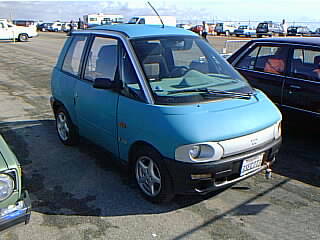
Home - AFV Events - Other AFV Events - Alameda EV Expo
The second (I think) annual International Electric Vehicle Exposition was held in Alameda, CA, across the bay from San Francisco, on 24-25 October 1998. It was organized by the city of Alameda and CALSTART, the advanced transportation industry development project that has a small-business "incubator" at Alameda on the site of the former Naval Air Station. I drove up there in my natural-gas-powered van after work on Friday, and went to the Expo and drove back to Los Angeles on Saturday. Driving mostly on California Highway 99, I refueled in Bakersfield, Fresno, and Modesto on each leg of the journey, and I could easily have skipped either Fresno or Bakersfield in each direction. Despite being 10% of the length of my journey Clean Across America And Back, this was a pretty easy trip.
The weather on Saturday morning was rainy, so the start of the Expo was postponed until after lunch; luckily for me, I had decided to sleep in that morning in Modesto, so I didn't have to kill a lot of time once I got to Alameda! The three main attractions at the Expo were electric-vehicle races (there was one much-modified Mazda there that could run a standing quarter mile in under twelve seconds!), exhibits of just about every electric vehicle being manufactured by a major automaker (and some not-so-major ones too), and a ride-and-drive area.

There was a pretty good turnout Saturday; there were at least a couple of hundred cars in the parking lot (including, not surprisingly, a few EV's), and throughout the day there were always several dozen people lined up to test-drive almost a dozen different EV's around a cone-marked area of the former airstrip. Here you can see a Honda EV Plus and a Nissan Altra pulling away beyond the Toyota RAV4-EV; in the background are some General Motors EV1's and a couple of electric Ford Ranger pickups. Others were hidden behind the EV1's and Fords or out on the course when I took this photo, including the Solectria Force (a converted Chevy Metro) and some of the vehicles pictured below. There was also a lot of interest in the racing (both straight-line and road-course) that began once the sun dried off the airstrip surface, but I don't have a telephoto lens for my digital camera so I don't have any good photos to show...
On static display, as I remarked above, were examples of just about every production or near-production EV with which I'm familiar. Two themes stood out, in my view: first, all the major automakers are shifting from lead-acid to advanced batteries. The Nissan Altra takes the prize for exotic technology, with its lithium-ion batteries (I know they're already commercially available--I have one in this PowerBook on which I'm typing--but they are still exotic in sizes large enough to power a vehicle!), and the Honda EV Plus and Toyota Prius and RAV4-EV have had nickel metal-hydride (NiMH) batteries (like those in my digital camera) from the start. This year, though, Dodge switched from lead-acid to NiMH for all of their EPIC (Electric Powered Interurban Commuter) minivans, as they stepped up production of this lease-only fleet vehicle:

... and the Chevrolet S-10 and Ford Ranger electric pickup trucks are now available with NiMH batteries, though these two vehicles are also still available with lead-acid packs. Asking around, I found that NiMH-powered vehicles are mostly leasing (where they are available--some in 50 states, some only in California and New York) for around $450 a month. It also seems that many of the automakers are providing a "cushion" to even out the various incentives that differ from state to state; without this, for example, an EV1 leases for $399 a month in southern California, but around $150 more in Arizona.

One interesting comparison between the Chevy and Ford pickups is their drivetrains: in gasoline form, both have a conventional front-engine/rear-drive layout, but neither is set up that way in their electric variants! The Chevy S-10 has a front-motor/front-drive layout derived from that in the GM EV1, while the Ford has its motor driving the rear wheels from a mounting position just above them:

It looks like there isn't much ground clearance there under the non-live-axle crossmember, but it's actually no less than that below the differential on a gasoline pickup, I'm told--it's just that the minimum clearance goes all the way across instead of just being in the middle, as with a differential "pumpkin".
The second theme that I noted at the EV Expo was the large number of small cars on display! I mean really small, as in two-seaters that are about the size of a golf cart, but that have freeway-capable top speeds and street-legal safety features. In some gated communities, country clubs, college campuses, etc., so-called "Neighborhood Electric Vehicles" or even ordinary golf carts are street-legal with top speeds of 25 MPH, but here we are talking about go-anywhere cars that just happen to be sized for a solo commute rather than a family outing. The first one of these I had heard of was the PIVCO City Bee, from Norway:

This little car was actually out in the parking lot, not inside on display; several dozen have been involved in a station car demonstration project in the area, where they were available for rent at Bay Area Rapid Transit (BART) stations so that participants in the program could ride mass transit to work but still have a car available for running errands at lunch and the like. The City Bee was a prototype, and its successor is nearly ready to go into production for sale (initially) in Scandinavia. This is the production model of the TH!NK (yes, I spelled that correctly), a couple of which were also in the ride and drive area:

Also on display was the Reva, a prototype designed by advanced-technology firm Amerigon and intended to be produced and sold at low cost in India (actually, this is kind of in between a 25-MPH Neighborhood Electric Vehicle and a freeway-capable car, since it has a top speed of 40 MPH):

Finally, next to the same Prius hybrid-EV that I saw in Anaheim last weekend, Toyota displayed its e-com prototype (note right-hand drive, for planned Japanese introduction):

In my travels to Europe, I have noticed that most automakers that do business both there and in the United States have at least one smaller-size car in Europe than the smallest one available here. For example, Mazda's cars here go down in size from the 929 to the 626 to the 323, but in Europe there's also a 121! In countries where gasoline prices are taxed into the stratosphere, cars that are smaller and less fuel-thirsty are a lot more popular than here (and I suppose having cities that grew up long before the automobile, in which there's no room for wide streets and big parking lots in many areas, also makes a difference). These are the places where consumers are likely to see nothing odd about a car that doesn't take up six or eight people's worth of space for a typical solo commute. In the United States, an approach from the other direction is being tried: let the small commuter EV be sold not as a tiny alternative to a conventional car, but as a safe, enclosed alternative to a motorcycle! This is the approach taken with the Corbin Sparrow:

This is a three-wheel, one-seat electric vehicle (Corbin's term is "Personal Transit Module") that protects its occupant with architecture like that of a motorcycle helmet--they even positioned the door with safety in mind, since putting it on the right means (1) the driver can step out on the sidewalk side when parallel-parked and (2) the left front area, which is the most likely place to get hit in a collision, is one solid piece for strength since there's no left door. Corbin has a splendid reputation for quality motorcycle saddles and accessories, and the fit and finish on the Sparrow is worthy of their name. I came that close to ordering one instead of the Harley-Davidson 883 Sportster I bought in November 1997; unfortunately, I couldn't afford the cost difference between $12900 and $5400. But I gotta tell you, if I had gone to the L.A. Auto Show in January 1998, where I first saw Sparrows "in the flesh" (I'd been following their progress on their website up to then), before I got the Harley, I might have said the heck with the extra money! It is a beautiful vehicle, perfectly designed for the task of handling the vast bulk of most people's driving, which is to say, a solo commute of average length plus assorted light errands. Its range of 40-60 miles between rechargings, its ability to get an opportunity charge from any 110-volt outlet while parked at work, and its couple-bags-of-groceries cargo area are all more than up to the job. If I had a Sparrow, or one of these other bigger-than-a-motorcycle, smaller-than-a-sport-utility-vehicle commuter electric vehicles, I could park my van entirely except for when I need to drive across the state or across the country...
 Back
to AFV Events Page
Back
to AFV Events Page Back
to Fueling Station
Back
to Fueling Station Site
Map
Site
Map Contact
Me
Contact
Me All content copyright 1998-2024 by Mark Looper, except as noted. Reuse of my copyrighted material is authorized under Creative Commons Attribution 4.0 International license (CC BY 4.0).
![]()
![]()
new 25 October 1998